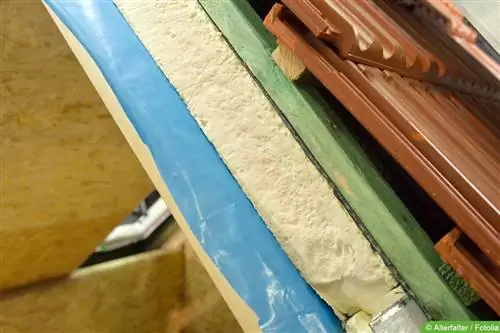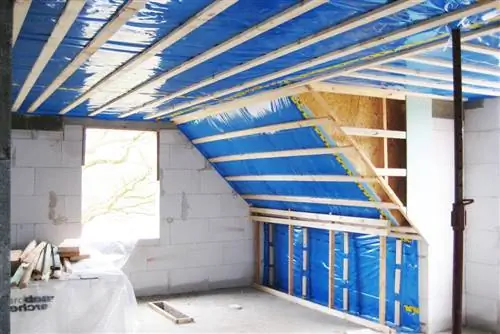- Author admin [email protected].
- Public 2023-12-17 03:39.
- Last modified 2025-01-24 12:45.
Vapour barrier and vapor barrier are important elements when building or expanding rooms. You can find out where they need to be moved here.
Vapor barrier or vapor barrier?
Although the terms are often used interchangeably, they are different materials. A vapor barrier is used when the sd value is between 0.6 and 1,500 meters. The vapor barrier is used from 1,500 meters.
The sd value stands for “water vapor diffusion equivalent air layer thickness” and indicates the resistance the material has to water vapor.
Before laying, it must be clear what value is given in order to make the right decision.
Function
Whether it is a barrier or a brake: it is a material that prevents water vapor or humidity from penetrating the wall insulation. It should therefore be installed in any room that is exposed to increased humidity. These include:
- Bath
- Roof
- Kitchen
- Laundry room
Rooms with lots of leafy plants, indoor fountains or aquariums can also be included. The roof should definitely be equipped with this, as warm and therefore potentially more humid air rises and spreads through the building structure. The possible consequences of this are:
- Building materials become rotten
- Rot
- Mold
On the one hand, this can result in substances that are hazardous to he alth and spread through the air in the room. On the other hand, the building structure suffers. This can generate high costs and also entail immense effort.
Possible materials
Various materials can be used for the locks and brakes. These include, for example:
- Aluminium
- Plastics, such as polyethylene or PVC
- OSB3 and OSB4
- Paper
It is often foil, but in the case of aluminum and OSB, panels can also be used. Both variants have advantages and disadvantages.
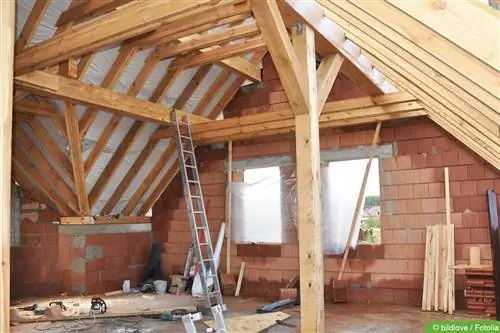
Foil
The advantages of vapor barriers in foil form are:
- easy cropping
- lower weight
- easier to install
Another advantage is that the film can be applied more flexibly. In the case of difficult sloping roofs, bay windows or other structural features, this makes work easier and can significantly reduce the effort. The disadvantage, however, is that foils can become damaged more quickly than panels and therefore may have to be replaced more frequently.
Note:
The seams are also comparatively easy to close. In addition, the structure is space-saving and therefore reduces the space taken up.
Records
Fixed panels have the following advantages:
- offers a good surface for attaching the cladding
- durable
- stable
However, they are heavier and less flexible when attached. Cropping is also more difficult.
Note:
Plates can only be laid by two people. So organize at least one helper for this task.
Laying foil
In order to create an effective barrier against steam and humidity, a few factors must be taken into account when installing. But first you need the right utensils. These are:
- Scrip pen
- cutter knife
- Foil
- tacker if necessary
- Adhesive tape
- Glue
- Measuring tools, such as folding ruler and scaled angle
- Spatula
If the equipment is ready, the following steps are required:
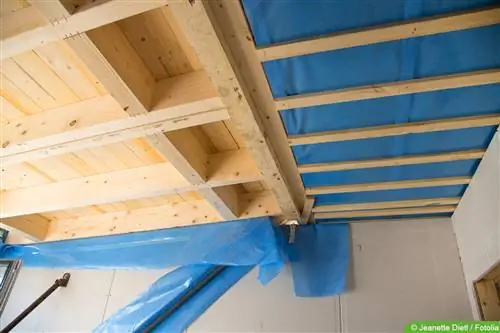
1. Cleaning
The surface is swept before laying. It should be smooth and swept clean.
2. Lay out foil
The film is rolled out so that it extends from one rafter to the next and overhangs both the walls and the rafters.
3. Measure and cut
The vapor barrier should protrude at least two centimeters on walls. It even has to be ten centimeters on the rafters. Please also take into account any necessary cutouts, such as for load-bearing beams.
4. Lay out
After cutting, the film is laid out and aligned again. It should also be smoothed well with the spatula.
5. Fasten
You can staple the vapor barriers to the rafters at regular intervals. However, they are stuck to walls and other vertical surfaces. To do this, fold two centimeters of the edge upwards to form a fold. The adhesive is applied between the wall and the foil and smoothed out with a spatula. There should be no air bubbles underneath.
Tip:
Choose glue and adhesive tape to match the film. In some cases complete systems can be found. These make the selection easier.
Seams
The seams of the vapor barrier must overlap each other by ten centimeters. They also have to be glued together. However, only adhesive tape is required for this. Make sure the edges are sealed tightly and evenly.
Laying panels
If you are laying panels, the process is similar. After measuring, cut them accordingly. In contrast to the film, however, a saw and not a cutter knife are required for this. They can also be screwed to the rafters to provide more stability.
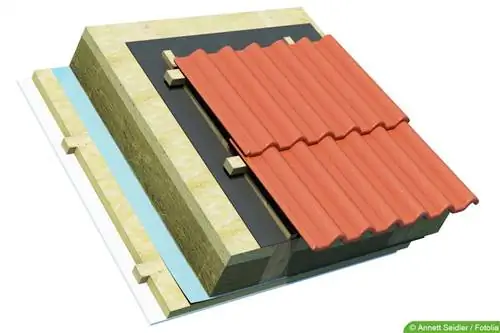
Joints
With panels as a vapor barrier, it is of course not possible to overlap the individual elements. Otherwise unevenness would occur. They must therefore be aligned so that the resulting joints are as small as possible.
It is also necessary to glue the joints between the panels and the gaps to the walls. Otherwise, water vapor could still penetrate the insulation. Parquet floor adhesives and assembly adhesives are suitable for this.
Tip:
A cartridge gun helps to fill the glue into narrower joints. It also helps if the side edges are already glued before aligning and after screwing.

